Industrial Drying of Fruit and Vegetable Products: Customized Smart Monitoring and Analytical Characterization of Process Variables in the OTTORTO Project
Abstract
:1. Introduction
2. Materials and Methods
- Analysis of the conventional drying process of fruit and vegetable products.
- Implementation of intelligent systems for monitoring the drying process of fruit and vegetable products.
- Statistical analysis of the process variables for evaluating the operating status of the production line.
2.1. Analysis of the Conventional Drying Process of Fruit and Vegetable Products
2.1.1. Main Phases of Dehydration
Process 1—Evaporation of Excess Moisture Due to Energy in the Form of Heat in the Surrounding Environment
Process 2—Transfer of Bound Moisture from the Interior of the Solid to Its Surface, Where Such Moisture Evaporates by Process 1
2.2. Realization of Intelligent Systems for Monitoring the Drying Process of Fruit and Vegetable Products
2.2.1. The Production Line
2.2.2. Multiparameter Monitoring System Assembly
The Smart Devices
Signal Processing
Monitoring Spots
Monitoring Campaigns
2.3. Statistical Analysis of Process Variables for Evaluating the Operating Status of the Production Line
3. Results and Discussion
4. Conclusions
Author Contributions
Funding
Data Availability Statement
Acknowledgments
Conflicts of Interest
References
- Jideani, A.I.; Silungwe, H.; Takalani, T.; Omolola, A.O.; Udeh, H.O.; Anyasi, T.A. Antioxidant-rich natural fruit and vegetable products and human health. Int. J. Food Prop. 2021, 24, 41–67. [Google Scholar] [CrossRef]
- Bustos, A.Y.; Font, G.; Taranto, M.P. Fruits and vegetables snacks as carriers of probiotics and bioactive compounds: A review. Int. J. Food Sci. Technol. 2023, 58, 3211–3223. [Google Scholar] [CrossRef]
- Iovinella, M.; Lombardo, F.; Ciniglia, C.; Palmieri, M.; di Cicco, M.R.; Trifuoggi, M.; Race, M.; Manfredi, C.; Lubritto, C.; Fabbricino, M.; et al. Bioremoval of Yttrium (III), Cerium (III), Europium (III), and Terbium (III) from Single and Quaternary Aqueous Solutions Using the Extremophile Galdieria sulphuraria (Galdieriaceae, Rhodophyta). Plants 2022, 11, 1376. [Google Scholar] [CrossRef] [PubMed]
- Di Cicco, M.R.; Iovinella, M.; Palmieri, M.; Lubritto, C.; Ciniglia, C. Extremophilic Microalgae Galdieria Gen. for Urban Wastewater Treatment: Current State, the Case of “POWER” System, and Future Prospects. Plants 2021, 10, 2343. [Google Scholar] [CrossRef]
- Renugadevi, K.; Nachiyar, C.V.; Sowmiya, P.; Sunkar, S. Antioxidant activity of phycocyanin pigment extracted from marine filamentous cyanobacteria Geitlerinema sp TRV57. Biocatal. Agric. Biotechnol. 2018, 16, 237–242. [Google Scholar] [CrossRef]
- Sydney, E.B.; Schafranski, K.; Barretti, B.R.V.; Sydney, A.C.N.; Zimmerman, J.F.D.A.; Cerri, M.L.; Mottin Demiate, I. Biomolecules from extremophile microalgae: From genetics to bioprocessing of a new candidate for large-scale production. Process Biochem. 2019, 87, 37–44. [Google Scholar] [CrossRef]
- Jayaraman, K.; Gupta, D.D. Drying of fruits and vegetables. In Handbook of Industrial Drying; CRC Press: Boca Raton, FL, USA, 2020; pp. 643–690. [Google Scholar]
- Sruthy, G.N.; Sandhya, K.R.; Kumkum, C.R.; Mythri, R.; Sharma, M. Chapter 10—Thermal processing technologies for food. In Current Developments in Biotechnology and Bioengineering; Tarafdar, A., Pandey, A., Sirohi, R., Soccol, C., Dussap, C.-G., Eds.; Elsevier: Amsterdam, The Netherlands, 2022; pp. 263–300. [Google Scholar]
- Hii, C.L.; Ong, S.P.; Yap, J.Y.; Putranto, A.; Mangindaan, D. Hybrid drying of food and bioproducts: A review. Dry. Technol. 2021, 39, 1554–1576. [Google Scholar] [CrossRef]
- Michailidis, P.A.; Krokida, M.K. Drying and Dehydration Processes in Food Preservation and Processing. Conv. Adv. Food Process. Technol. 2014, 1–32. [Google Scholar] [CrossRef]
- Maruyama, S.; Streletskaya, N.A.; Lim, J. Clean label: Why this ingredient but not that one? Food Qual. Prefer. 2021, 87, 104062. [Google Scholar] [CrossRef]
- Ranganath, K.G. Pigments that colour our fruits: An overview. Erwerbs-Obstbau 2022, 64, 535–547. [Google Scholar] [CrossRef]
- Yan, M.R.; Hsieh, S.; Ricacho, N. Innovative food packaging, food quality and safety, and consumer perspectives. Processes 2022, 10, 747. [Google Scholar] [CrossRef]
- Lang, B.; Conroy, D.M. When food governance matters to consumer food choice: Consumer perception of and preference for food quality certifications. Appetite 2022, 168, 105688. [Google Scholar]
- Ghufran, M.; Ali, S.; Ariyesti, F.R.; Nawaz, M.A.; Aldieri, L.; Xiaobao, P. Impact of COVID-19 to customers switching intention in the food segments: The push, pull and mooring effects in consumer migration towards organic food. Food Qual. Prefer. 2022, 99, 104561. [Google Scholar] [CrossRef]
- Nurhaslina, C.R.; Andi Bacho, S.; Mustapa, A.N. Review on drying methods for herbal plants. Mater. Today Proc. 2022, 63, S122–S139. [Google Scholar] [CrossRef]
- Igual, M.; Martínez-Monzó, J. Physicochemical Properties and Structure Changes of Food Products during Processing. Foods 2022, 11, 2365. [Google Scholar] [CrossRef]
- Tuly, S.S.; Mahiuddin, M.; Karim, A. Mathematical modeling of nutritional, color, texture, and microbial activity changes in fruit and vegetables during drying: A critical review. Crit. Rev. Food Sci. Nutr. 2023, 63, 1877–1900. [Google Scholar] [CrossRef]
- Mujumdar, A.S.; Menon, A.S. Drying of solids: Principles, classification, and selection of dryers. In Handbook of Industrial Drying; CRC Press: Boca Raton, FL, USA, 2020; pp. 1–39. [Google Scholar]
- Sagar, V.; Suresh Kumar, P. Recent advances in drying and dehydration of fruits and vegetables: A review. J. Food Sci. Technol. 2010, 47, 15–26. [Google Scholar] [CrossRef]
- Jin, X.; van der Sman, R.G.M. Interaction between large deformation and moisture transport during dehydration of vegetables. Food Struct. 2022, 32, 100269. [Google Scholar] [CrossRef]
- Akter, F.; Muhury, R.; Sultana, A.; Deb, U.K. A Comprehensive Review of Mathematical Modeling for Drying Processes of Fruits and Vegetables. Int. J. Food Sci. 2022, 2022, 6195257. [Google Scholar] [CrossRef]
- El-Mesery, H.S. Improving the thermal efficiency and energy consumption of convective dryer using various energy sources for tomato drying. Alex. Eng. J. 2022, 61, 10245–10261. [Google Scholar] [CrossRef]
- Du, Y.; Yang, F.; Yu, H.; Xie, Y.; Yao, W. Improving food drying performance by cold plasma pretreatment: A systematic review. Compr. Rev. Food Sci. Food Saf. 2022, 21, 4402–4421. [Google Scholar] [CrossRef] [PubMed]
- Osman, A.I.; Chen, L.; Yang, M.; Msigwa, G.; Farghali, M.; Fawzy, S.; Rooney, D.W.; Yap, P.-S. Cost, environmental impact, and resilience of renewable energy under a changing climate: A review. Environ. Chem. Lett. 2023, 21, 741–764. [Google Scholar] [CrossRef]
- Greve, H.; Lay, J.; Negrete, A. How vulnerable are small firms to energy price increases? Evidence from Mexico. Environ. Dev. Econ. 2023, 28, 89–109. [Google Scholar] [CrossRef]
- Yasmeen, R.; Zhang, X.; Tao, R.; Shah, W.U.H. The impact of green technology, environmental tax and natural resources on energy efficiency and productivity: Perspective of OECD Rule of Law. Energy Rep. 2023, 9, 1308–1319. [Google Scholar] [CrossRef]
- Chien, F.; Huang, L.; Zhao, W. The influence of sustainable energy demands on energy efficiency: Evidence from China. J. Innov. Knowl. 2023, 8, 100298. [Google Scholar] [CrossRef]
- Tseng, C.-J.; Chetthamrongchai, P.; Mahmudiono, T.; Sharma, S.K.; Al-Awsi, G.R.L.; Abed, S.A.; Mohammed, F.; Opulencia, M.J.C.; Rudiansyah, M. Sustainability assessment of food industry with the approach of water, energy and food nexus. Food Sci. Technol. 2022, 42, e37922. [Google Scholar] [CrossRef]
- Bradu, P.; Biswas, A.; Nair, C.; Sreevalsakumar, S.; Patil, M.; Kannampuzha, S.; Mukherjee, A.G.; Wanjari, U.R.; Renu, K.; Vellingiri, B. Recent advances in green technology and Industrial Revolution 4.0 for a sustainable future. Environ. Sci. Pollut. Res. 2022, 1–32. [Google Scholar] [CrossRef]
- Morrissey, J.; Heidkamp, P. Sustainability after COVID-19: Pillars for a just transition. Environ. Sustain. 2022, 5, 261–269. [Google Scholar] [CrossRef]
- Di Cicco, M.R.; Palmieri, M.; Altieri, S.; Ciniglia, C.; Lubritto, C. Cultivation of the Acidophilic Microalgae Galdieria phlegrea with Wastewater: Process Yields. Int. J. Environ. Res. Public Health 2021, 18, 2291. [Google Scholar] [CrossRef]
- Sirakov, M.; Palmieri, M.; Iovinella, M.; Davis, S.J.; Petriccione, M.; di Cicco, M.R.; De Stefano, M.; Ciniglia, C. Cyanidiophyceae (Rhodophyta) Tolerance to Precious Metals: Metabolic Response to Palladium and Gold. Plants 2021, 10, 2367. [Google Scholar] [CrossRef]
- Yadav, V.; Sarker, A.; Yadav, A.; Miftah, A.O.; Bilal, M.; Iqbal, H.M. Integrated biorefinery approach to valorize citrus waste: A sustainable solution for resource recovery and environmental management. Chemosphere 2022, 293, 133459. [Google Scholar] [CrossRef] [PubMed]
- Devi, C.; Khwairakpam, M. Resource recovery and value addition of terrestrial weeds through vermicomposting. In Advanced Organic Waste Management; Elsevier: Amsterdam, The Netherlands, 2022; pp. 155–175. [Google Scholar]
- Paunov, C.; Planes-Satorra, S. How are digital technologies changing innovation?: Evidence from agriculture, the automotive industry and retail. OECD Sci. Technol. Ind. Policy Pap. 2019, 74. [Google Scholar] [CrossRef]
- Vetromile, C.; Spagnuolo, A.; Petraglia, A.; Masiello, A.; di Cicco, M.R.; Lubritto, C. Pre- and post-operam comparison of the energy consumption of a radio base station under energy efficiency actions. Energy Build. 2021, 236, 110772. [Google Scholar] [CrossRef]
- Di Cicco, M.R.; Masiello, A.; Spagnuolo, A.; Vetromile, C.; Borea, L.; Giannella, G.; Iovinella, M.; Lubritto, C. Real-Time Monitoring and Static Data Analysis to Assess Energetic and Environmental Performances in the Wastewater Sector: A Case Study. Energies 2021, 14, 6948. [Google Scholar] [CrossRef]
- Spagnuolo, A.; De Santo, G.; Vetromile, C.; Masiello, A.; Di Costanzo, P.; Esposito, S.; Buono, U.; di Cicco, M.R.; Lubritto, C. Characterizing passenger-ship emissions: Towards improved sustainability for MedMar fleet (gulf of Naples). Energy Effic. 2022, 15, 55. [Google Scholar] [CrossRef]
- Di Cicco, M.R.; Spagnuolo, A.; Masiello, A.; Vetromile, C.; Nappa, M.; Lubritto, C. Energetic and environmental analysis of a wastewater treatment plant through static and dynamic monitoring activities. Int. J. Environ. Sci. Technol. 2020, 17, 4299–4312. [Google Scholar] [CrossRef]
- Di Cicco, M.R.; Spagnuolo, A.; Masiello, A.; Vetromile, C.; Nappa, M.; Corbo, G.; Lubritto, C. Assessing energy performance and critical issues of a large wastewater treatment plant through full-scale data benchmarking. Water Sci. Technol. 2019, 80, 1421–1429. [Google Scholar] [CrossRef]
- Di Cicco, M.R.; Spagnuolo, A.; Masiello, A.; Vetromile, C.; Nappa, M.; Corbo, G.; Lubritto, C. Energy Monitoring of a Wastewater Treatment Plant in Salerno, Campania Region (Southern Italy). In Frontiers in Water-Energy-Nexus—Nature-Based Solutions, Advanced Technologies and Best Practices for Environmental Sustainability, Proceedings of the 2nd WaterEnergyNEXUS Conference, November 2018, Salerno, Italy, 19 September 2019; Springer: Cham, Switzerland, 2020. [Google Scholar]
- Bermeo-Ayerbe, M.A.; Ocampo-Martinez, C.; Diaz-Rozo, J. Data-driven energy prediction modeling for both energy efficiency and maintenance in smart manufacturing systems. Energy 2022, 238, 121691. [Google Scholar] [CrossRef]
- Nižetić, S.; Djilali, N.; Papadopoulos, A.; Rodrigues, J.J.P.C. Smart technologies for promotion of energy efficiency, utilization of sustainable resources and waste management. J. Clean. Prod. 2019, 231, 565–591. [Google Scholar] [CrossRef]
- Ahmad, T.; Zhang, D.; Huang, C.; Zhang, H.; Dai, N.; Song, Y.; Chen, H. Artificial intelligence in sustainable energy industry: Status Quo, challenges and opportunities. J. Clean. Prod. 2021, 289, 125834. [Google Scholar] [CrossRef]
- Meng, Y.; Yang, Y.; Chung, H.; Lee, P.-H.; Shao, C. Enhancing sustainability and energy efficiency in smart factories: A review. Sustainability 2018, 10, 4779. [Google Scholar] [CrossRef]
- Aslam, W.; Soban, M.; Akhtar, F.; Zaffar, N.A. Smart meters for industrial energy conservation and efficiency optimization in Pakistan: Scope, technology and applications. Renew. Sustain. Energy Rev. 2015, 44, 933–943. [Google Scholar] [CrossRef]
- Liu, Z.; Xie, K.; Li, L.; Chen, Y. A paradigm of safety management in Industry 4.0. Syst. Res. Behav. Sci. 2020, 37, 632–645. [Google Scholar] [CrossRef]
- Ghoreishi, M.; Happonen, A. The Case of Fabric and Textile Industry: The Emerging Role of Digitalization, Internet-of-Things and Industry 4.0 for Circularity. In Proceedings of the Sixth International Congress on Information and Communication Technology, London, UK, 25–26 February 2021; Springer: Singapore, 2022; pp. 189–200. [Google Scholar]
- Pe’er, G.; Bonn, A.; Bruelheide, H.; Dieker, P.; Eisenhauer, N.; Feindt, P.H.; Hagedorn, G.; Hansjürgens, B.; Herzon, I.; Lomba, Â.; et al. Action needed for the EU Common Agricultural Policy to address sustainability challenges. People Nat. 2020, 2, 305–316. [Google Scholar] [CrossRef] [PubMed]
- Farooq, M.S.; Riaz, S.; Abid, A.; Umer, T.; Zikria, Y.B. Role of IoT Technology in Agriculture: A Systematic Literature Review. Electronics 2020, 9, 319. [Google Scholar] [CrossRef]
- Farooq, M.S.; Riaz, S.; Abid, A.; Abid, K.; Naeem, M.A. A Survey on the Role of IoT in Agriculture for the Implementation of Smart Farming. IEEE Access 2019, 7, 156237–156271. [Google Scholar] [CrossRef]
- Quy, V.K.; Hau, N.V.; Anh, D.V.; Quy, N.M.; Ban, N.T.; Lanza, S.; Randazzo, G.; Muzirafuti, A. IoT-Enabled Smart Agriculture: Architecture, Applications, and Challenges. Appl. Sci. 2022, 12, 3396. [Google Scholar] [CrossRef]
- Tapakire, B.A.; Patil, M.M. Iot based smart agriculture using thingspeak. Int. J. Eng. Res. Technol. 2019, 8, 270–274. [Google Scholar]
- Antony, A.P.; Leith, K.; Jolley, C.; Lu, J.; Sweeney, D.J. A review of practice and implementation of the internet of things (IoT) for smallholder agriculture. Sustainability 2020, 12, 3750. [Google Scholar] [CrossRef]
- Tao, W.; Zhao, L.; Wang, G.; Liang, R. Review of the internet of things communication technologies in smart agriculture and challenges. Comput. Electron. Agric. 2021, 189, 106352. [Google Scholar] [CrossRef]
- Shulla, K.; Filho, W.L.; Lardjane, S.; Sommer, J.H.; Borgemeister, C. Sustainable development education in the context of the 2030 Agenda for sustainable development. Int. J. Sustain. Dev. World Ecol. 2020, 27, 458–468. [Google Scholar] [CrossRef]
- Fellows, P.J. Food Processing Technology: Principles and Practice; Woodhead Publishing: Sawston, UK, 2022. [Google Scholar]
- Joardder, M.U.; Mourshed, M.; Masud, M.H. State of Bound Water: Measurement and Significance in Food Processing; Springer: Berlin/Heidelberg, Germany, 2019. [Google Scholar]
- Anandharamakrishnan, C. Introduction to drying. In Handbook of Drying for Dairy Products; Wiley Online Library: Hoboken, NJ, USA, 2017; pp. 1–14. [Google Scholar] [CrossRef]
- Qasem, S.N.; Samadianfard, S.; Sadri Nahand, H.; Mosavi, A.; Shamshirband, S.; Chau, K.-W. Estimating daily dew point temperature using machine learning algorithms. Water 2019, 11, 582. [Google Scholar] [CrossRef]
- Muñoz-García, M.A.; Moreda, G.P.; Raga-Arroyo, M.P.; Marín-González, O. Water harvesting for young trees using Peltier modules powered by photovoltaic solar energy. Comput. Electron. Agric. 2013, 93, 60–67. [Google Scholar] [CrossRef]
- Ambriz-Díaz, V.M.; Rubio-Maya, C.; Pacheco Ibarra, J.J.; Galván González, S.R.; Martínez Patiño, J. Analysis of a sequential production of electricity, ice and drying of agricultural products by cascading geothermal energy. Int. J. Hydrog. Energy 2017, 42, 18092–18102. [Google Scholar] [CrossRef]
- Kumar, A.; Singh, K.U.; Singh, M.K.; Kushwaha, A.K.S.; Kumar, A.; Mahato, S. Design and Fabrication of Solar Dryer System for Food Preservation of Vegetables or Fruit. J. Food Qual. 2022, 2022, 6564933. [Google Scholar] [CrossRef]
- Natarajan, S.K.; Elangovan, E.; Elavarasan, R.M.; Balaraman, A.; Sundaram, S. Review on solar dryers for drying fish, fruits, and vegetables. Environ. Sci. Pollut. Res. 2022, 29, 40478–40506. [Google Scholar] [CrossRef]
- Dongmo, M.; Aloyem Kaze, C.V.; Sayouba, J.P.D. Design and construction of a hybrid gas and biogas dryer for fruits, vegetables, meat and fish. E3S Web Conf. 2022, 354, 03008. [Google Scholar] [CrossRef]
- Gopinath, G.R.; Muthuvel, S.; Muthukannan, M.; Sudhakarapandian, R.; Praveen Kumar, B.; Santhan Kumar, C.; Thanikanti, S.B. Design, development, and performance testing of thermal energy storage based solar dryer system for seeded grapes. Sustain. Energy Technol. Assess. 2022, 51, 101923. [Google Scholar] [CrossRef]
- Wakjira, M. Solar drying of fruits and windows of opportunities in Ethiopia. Afr. J. Food Sci. 2010, 4, 790–802. [Google Scholar]
- Funebo, T.; Ohlsson, T. Microwave-assisted air dehydration of apple and mushroom. J. Food Eng. 1998, 38, 353–367. [Google Scholar] [CrossRef]
- Ekezie, F.-G.C.; Sun, D.-W.; Han, Z.; Cheng, J.-H. Microwave-assisted food processing technologies for enhancing product quality and process efficiency: A review of recent developments. Trends Food Sci. Technol. 2017, 67, 58–69. [Google Scholar] [CrossRef]
- Duan, X.; Zhang, M.; Mujumdar, A.; Wang, R. Trends in microwave-assisted freeze drying of foods. Dry. Technol. 2010, 28, 444–453. [Google Scholar] [CrossRef]
- Zhang, M.; Jiang, H.; Lim, R.-X. Recent developments in microwave-assisted drying of vegetables, fruits, and aquatic products—Drying kinetics and quality considerations. Dry. Technol. 2010, 28, 1307–1316. [Google Scholar] [CrossRef]
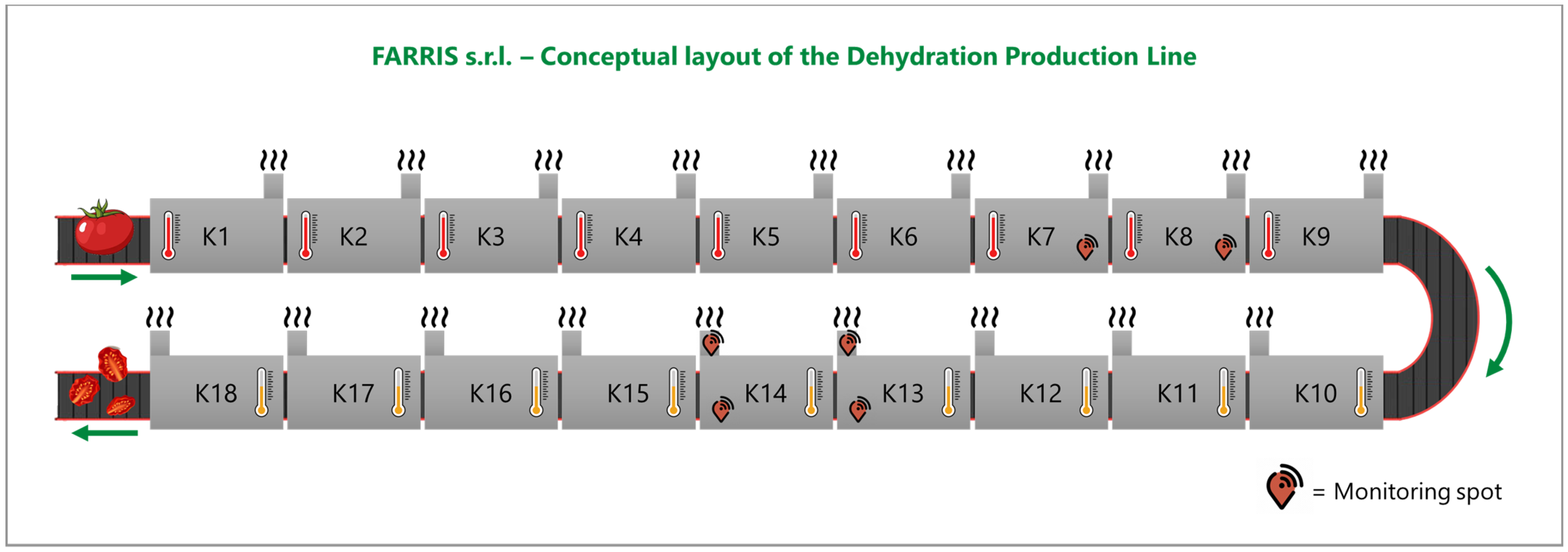

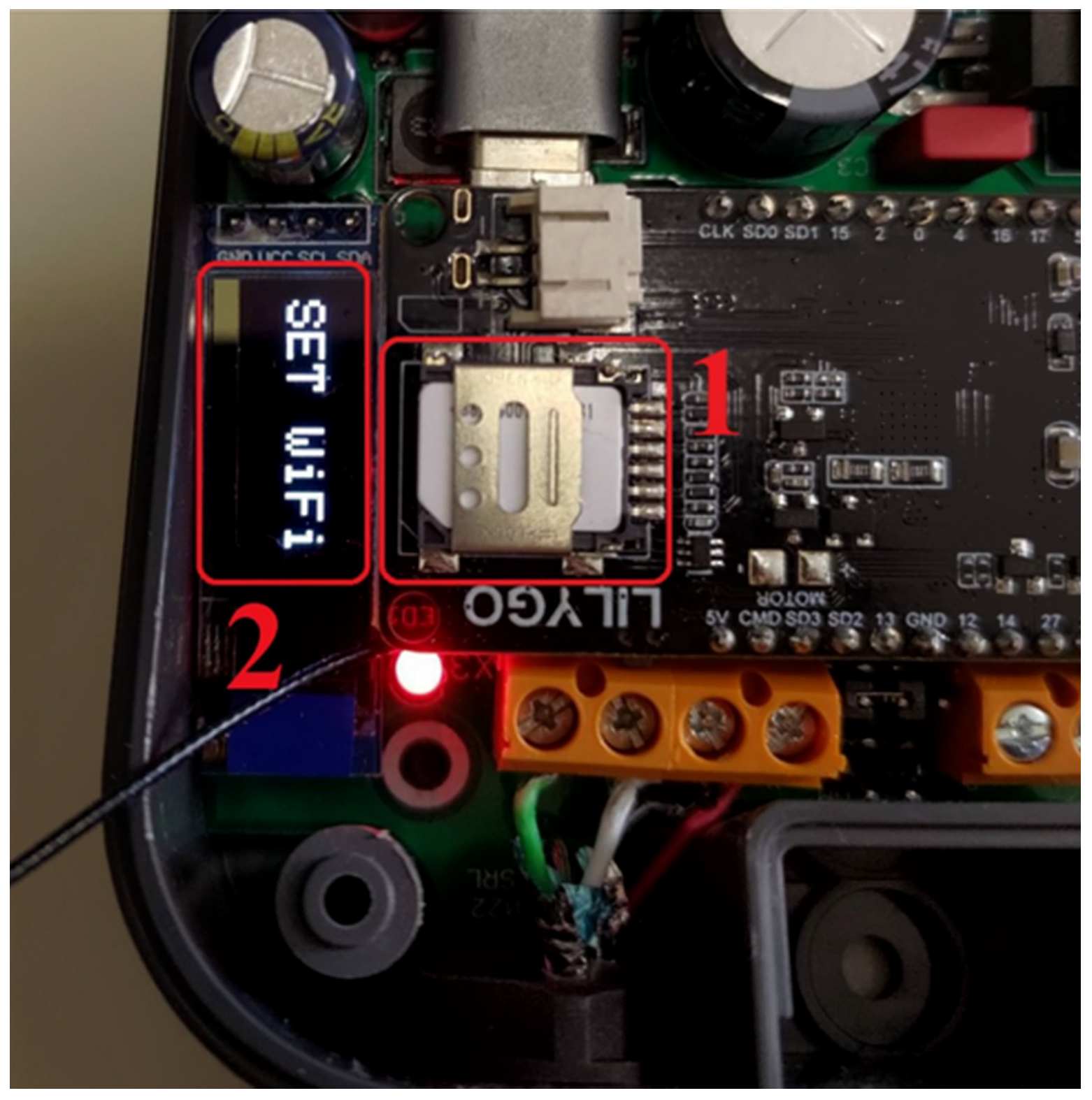

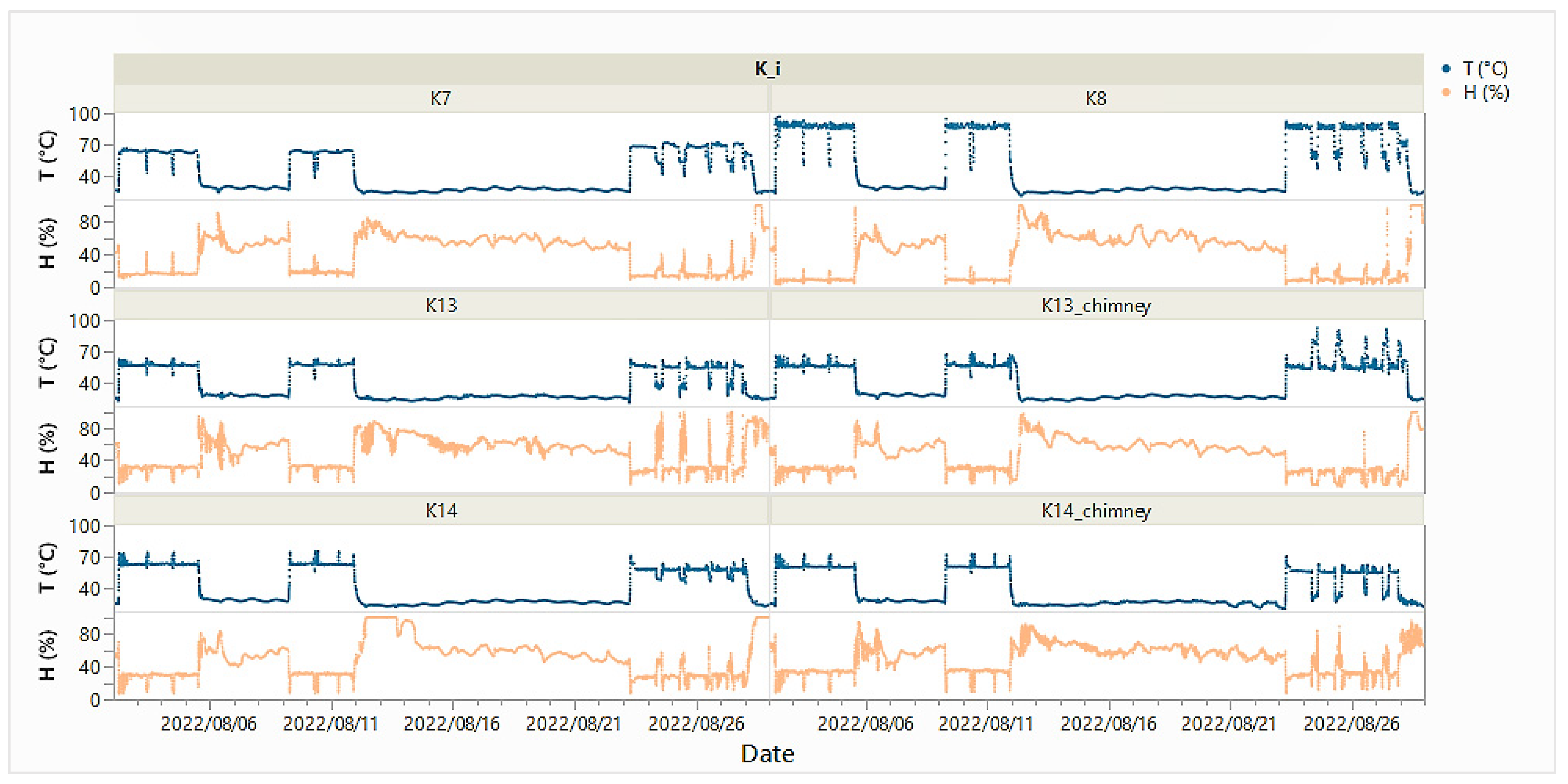
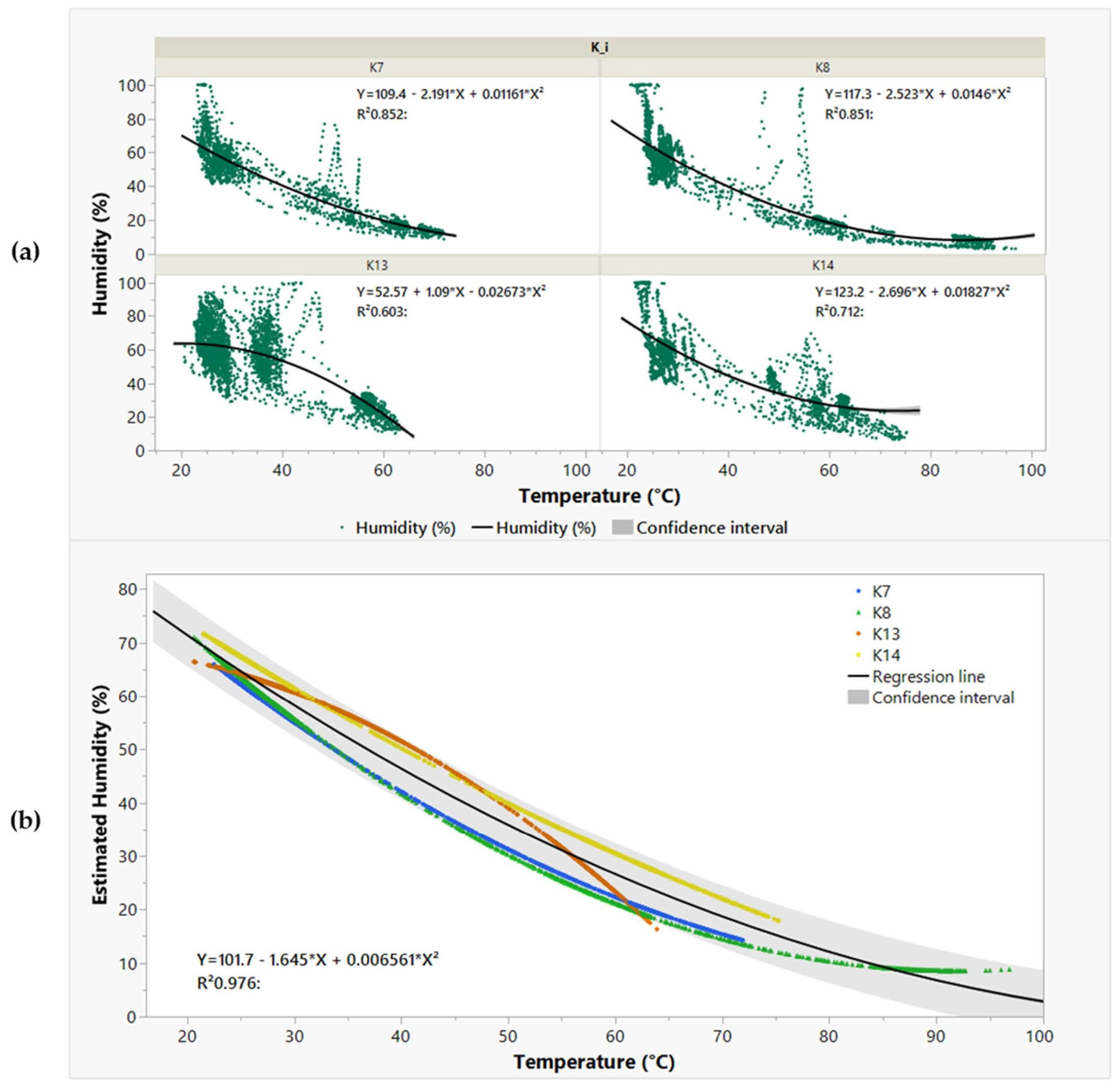
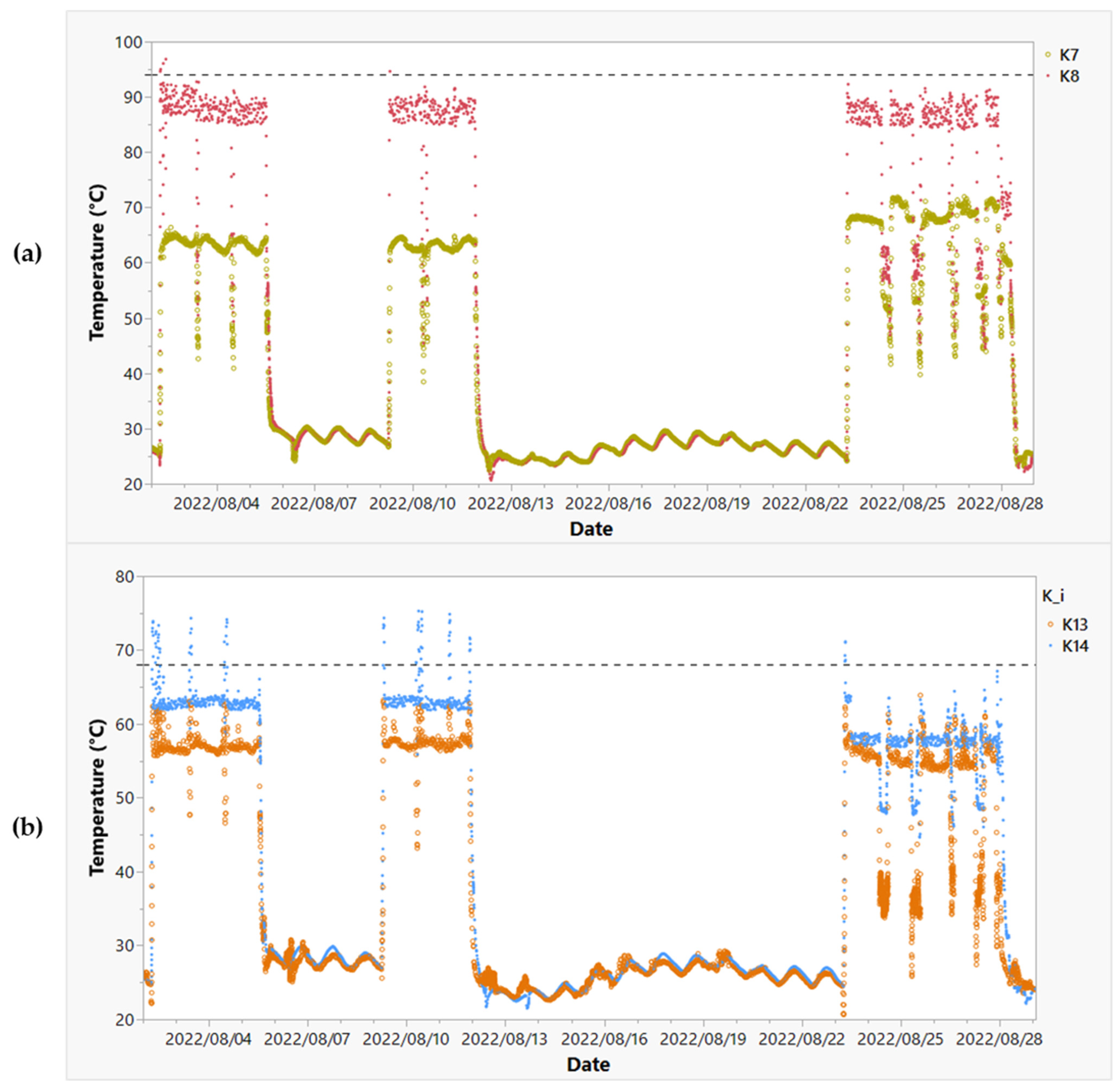

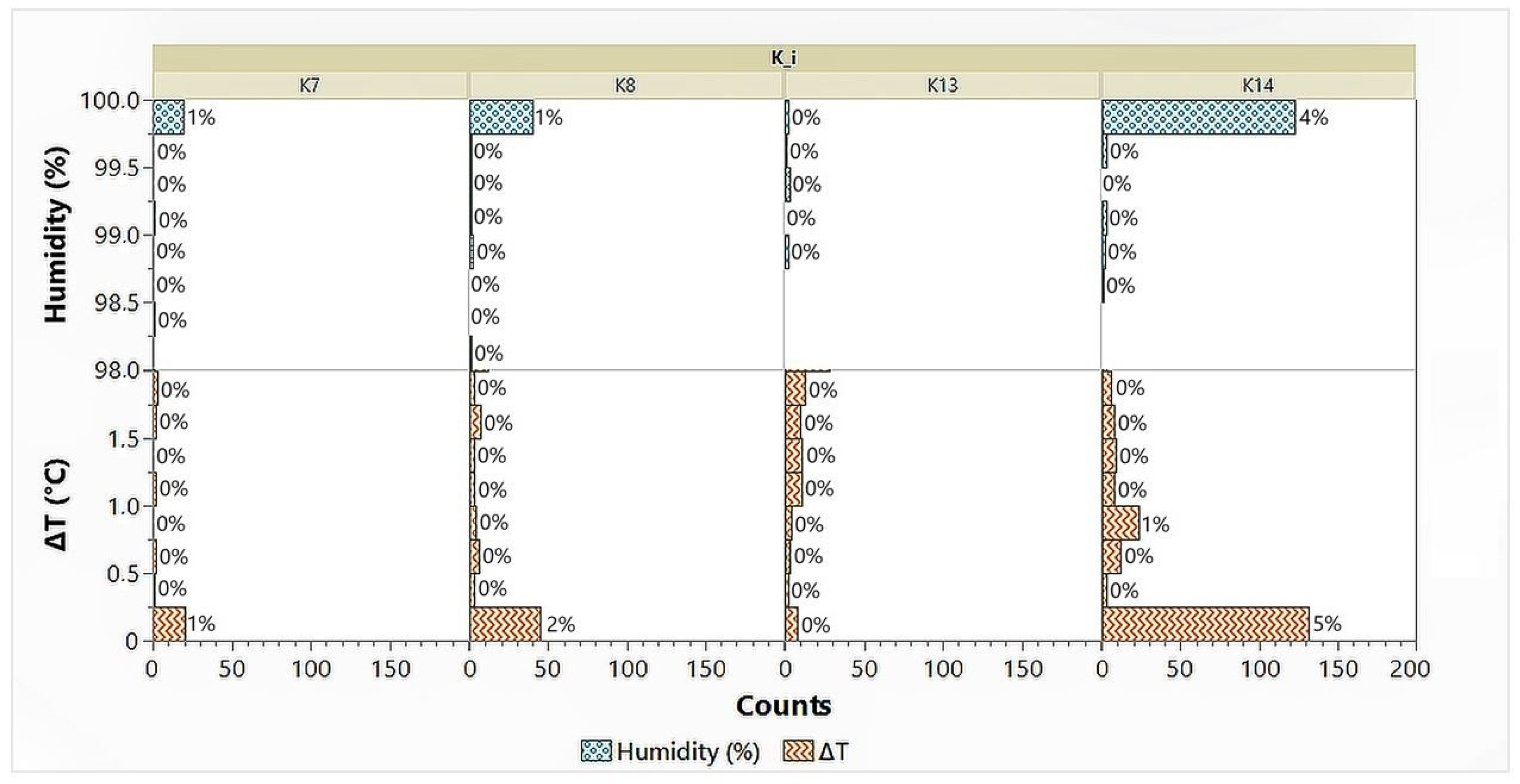
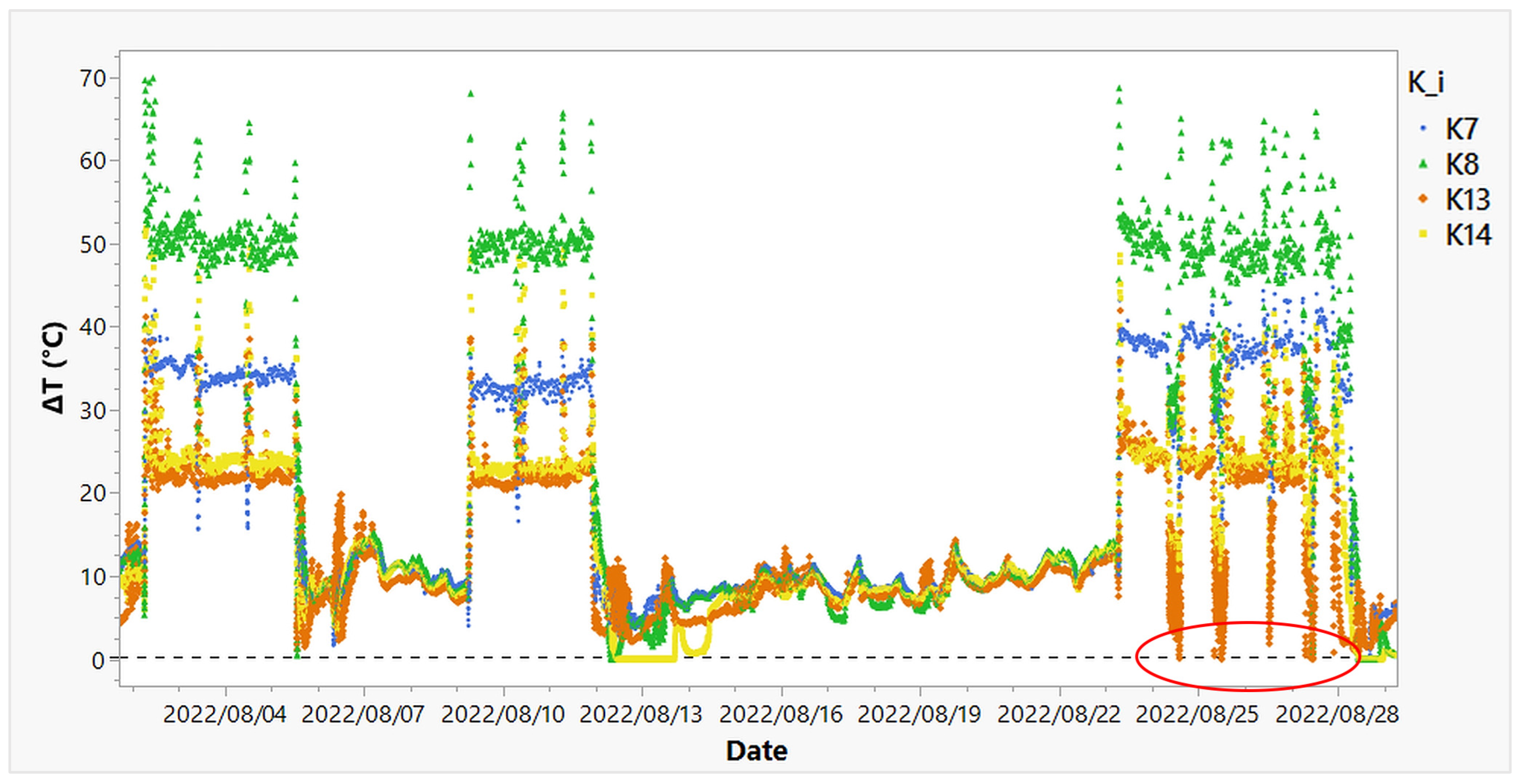
| Temperature (°C) | Humidity (%) | ΔT (°C) [Temperature—Dew Point] | Pearson Correlation Index ρHT: H vs. T | |||||||||||
|---|---|---|---|---|---|---|---|---|---|---|---|---|---|---|
| K_i | N | Mean | Min | Max | SD | Mean | Min | Max | SD | Mean | Min | Max | SD | |
| K7 | 2874 | 41.2 | 22.51 | 71.94 | 17.31 | 42.36 | 8.8 | 99.99 | 21.29 | 18.52 | 0 | 46.31 | 12.22 | −0.90 |
| K8 | 2826 | 49.62 | 20.64 | 96.83 | 27.06 | 38.7 | 3.01 | 99.99 | 26.4 | 24.88 | 0 | 69.84 | 19.61 | −0.89 |
| K13 | 4073 | 35.67 | 20.63 | 63.9 | 12.4 | 53.34 | 10.08 | 99.97 | 18.17 | 12.32 | 0.01 | 41.91 | 7.76 | −0.74 |
| K13_chimney | 2621 | 43.47 | 22.37 | 92.55 | 16.75 | 42.35 | 6.96 | 99.99 | 21.06 | 18.22 | 0 | 53.14 | 10.89 | −0.83 |
| K14 | 2824 | 43.02 | 21.52 | 75.27 | 16.8 | 46.16 | 6.4 | 99.99 | 21.77 | 16.37 | 0 | 51.87 | 10.03 | −0.80 |
| K14_chimney | 4092 | 36.14 | 20.19 | 72.66 | 14.61 | 52.21 | 7.53 | 95.65 | 18.12 | 12.9 | 0.74 | 48.78 | 8.33 | −0.79 |
| ALL | 19310 | 40.77 | 20.19 | 96.83 | 18.22 | 46.78 | 3.01 | 99.99 | 21.65 | 16.6 | 0 | 69.84 | 12.43 | −0.84 |
Disclaimer/Publisher’s Note: The statements, opinions and data contained in all publications are solely those of the individual author(s) and contributor(s) and not of MDPI and/or the editor(s). MDPI and/or the editor(s) disclaim responsibility for any injury to people or property resulting from any ideas, methods, instructions or products referred to in the content. |
© 2023 by the authors. Licensee MDPI, Basel, Switzerland. This article is an open access article distributed under the terms and conditions of the Creative Commons Attribution (CC BY) license (https://creativecommons.org/licenses/by/4.0/).
Share and Cite
Spagnuolo, A.; Vetromile, C.; Masiello, A.; De Santo, G.; Suriano, M.; Mercuri, G.; Pellegrino, M.; Piccolo, G.; Lubritto, C.; Di Cicco, M.R. Industrial Drying of Fruit and Vegetable Products: Customized Smart Monitoring and Analytical Characterization of Process Variables in the OTTORTO Project. Processes 2023, 11, 1635. https://doi.org/10.3390/pr11061635
Spagnuolo A, Vetromile C, Masiello A, De Santo G, Suriano M, Mercuri G, Pellegrino M, Piccolo G, Lubritto C, Di Cicco MR. Industrial Drying of Fruit and Vegetable Products: Customized Smart Monitoring and Analytical Characterization of Process Variables in the OTTORTO Project. Processes. 2023; 11(6):1635. https://doi.org/10.3390/pr11061635
Chicago/Turabian StyleSpagnuolo, Antonio, Carmela Vetromile, Antonio Masiello, Giuseppe De Santo, Mattia Suriano, Giorgio Mercuri, Michele Pellegrino, Giancarlo Piccolo, Carmine Lubritto, and Maria Rosa Di Cicco. 2023. "Industrial Drying of Fruit and Vegetable Products: Customized Smart Monitoring and Analytical Characterization of Process Variables in the OTTORTO Project" Processes 11, no. 6: 1635. https://doi.org/10.3390/pr11061635
APA StyleSpagnuolo, A., Vetromile, C., Masiello, A., De Santo, G., Suriano, M., Mercuri, G., Pellegrino, M., Piccolo, G., Lubritto, C., & Di Cicco, M. R. (2023). Industrial Drying of Fruit and Vegetable Products: Customized Smart Monitoring and Analytical Characterization of Process Variables in the OTTORTO Project. Processes, 11(6), 1635. https://doi.org/10.3390/pr11061635








